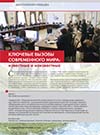Climate Change and Energy Transition
DOI: 10.33917/es-6.192.2023.16-29
The author shows that global warming is determined not by human activity, but by natural phenomena – primarily by a decrease in the inclination angle of the Earth’s rotation axis, changing the insolation of the polar/equatorial regions and, as a consequence, the intensity of meridional atmospheric-oceanic heat and mass transfer. The article presents results of measurements of the neutrino flux from the decay of the potassium-40 isotope, which confirmed the potassium content predicted by the theory of a hydrogen Earth, the flux of radiogenic heat from which must be taken into account in climate calculations. The article presents the results of experimental studies of hydrogen degassing from the depths of the Earth – the cause of the destruction of atmospheric ozone, the content of which in turn determines the temperature and pressure of the surface air. Spatial and temporal correlations of hydrogen degassing and ozone destruction, as well as the influence of gravitational forces of the Moon and the Sun on degassing, make it possible for the first time to make long-term forecasts of meteorological changes and the occurrence of climate disasters. The author substantiates the need for changes in climate and energy policy.
References:
1. Sherstyukov B.G. Global’noe poteplenie i ego vozmozhnye prichiny [Global Warming and its Possible Reasons]. Gidrometeorologiya i ekologiya, 2023, no 70, pp. 7–37, DOI: 10.33933/2713-3001-2023-70-7-37
2. Syvorotkin V.L. Neskonchaemaya tsep’ prestuplenii Monreal’skogo protokola [Never-Ending Chain of the Montreal Protocol Crimes]. IA Regnum, 2017, available at: https://regnum-ru.turbopages.org/regnum.ru/s/news/2302128.html
3. Callendar G.S. The artificial production of carbon dioxide and its influence on temperature. Quarterly Journal of the Royal Meteorological Society, 1938, vol. 64, no 275, pp. 223–240.
4. Keeling C.D. The Concentration and Isotopic Abundances of Carbon Dioxide in the Atmosphere. Tellus, 1960.
5. Schneider S.H., Azar C. Are Uncertainties in Climate and Energy Systems a Justification for Stronger Near-term Mitigation Policies? In Erlich, E. (ed.), Proceedings of the Pew Center Workshop on The Timing of Climate Change Policies. 2001. Washington D.C., 11, 12 October 2001, pp. 85–136, available at:
https://stephenschneider.stanford.edu/Publications/PDF_Papers/timingazarschneide.pdf
6. Schneider S H. The greenhouse effect: Science and policy. Science, 1989, vol. 243, pp. 771–781.
7. Schneide S.H. News Plays Fast and Loose With the Facts. Editorial. Detroit News, 1989, 5 December. 10A, available at: https://stephenschneider.stanford.edu/Publications/PDF_Papers/DetroitNews.pdf
8. Smirnov B.M. Fizika global’noi atmosfery. Parnikovyi effekt, atmosfernoe elektrichestvo, evolyutsiya klimata [Physics of the Global Atmosphere. Greenhouse Effect, Atmospheric Electricity, Climate Evolution]. Dolgoprudnyi, Intellekt, 2017, 256 p.
9. Demirchyan K.S., Kondrat’ev K.Ya., Demirchyan K.K. Global’noe poteplenie i “politika” ego predotvrashcheniya [Global Warming and the “Policy” of its Prevention]. Biosfera, 2010, vol. 2, no 4, pp. 488–502.





